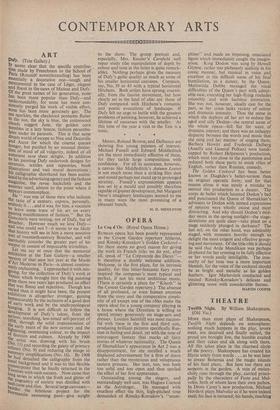CONTEMPORARY ARTS
ART
Try. (Tate Gallery.) seems clear that the specific contribu- tion made by Frenchmen to the School of rads (Rouaulr notwithstanding) has been essentially a decorative one—tough and monumental in the case of Leger, elegant and fluent in the cases of Matisse and Dufy. .0f the great names of his generation, none UaS been more popular than Dufy—and Understandably, for none has more con- sistently purged his work of visible effort, none has been more genuinely gay. The Sea sparkles, the checkered pennants flutter in the sun, the sky is blue, the cottonwool clouds suggest June, the golden corn trembles in a lazy breeze, fashion perambu- lates under its parasols. This is that same dream world of escape to Nice and Deauville Sind Ascot for which the cinema queues iiiinger, but purified by an unusual distinc- tion of mind of all 'vulgarity, indeed of all comment save sheer delight. In addition to his painting Dufy undertook designs for ceramics, textiles and tapestries, book illustrations and vast mural decorations ; his calligraphic shorthand has been assimi- lated by the advertising agency and the fashion Magazine, the revue backcloth and the summer scarf, almost to the point where it appears commonplace. He " was one of those men who indicate the taste of a century, express, personify, embody it ... and it was, for him, a vocation to leave some trace of his art on every Passing manifestation of fashion." ,But the Goncourts were writing, not of Dufy, but of Boucher. However much we love Dufy- and who could not ?—it seems to me likely that history will see in him a more sensitive sort of twentieth-century Boucher, and will inevitably consider the greater part of his output to consist of impeccable trivialities. Let me say at once that the memorial exhibition at the Tate Gallery—a smaller version of that seen last year at the Musee d:Art Modern in Paris—is almost continu- 'II* enchanting. I approached it with mis- giving, for the collection of Dufy's work at Venice which brought him the big painting Prize there two years ago produced an effect that was flimsy and repetitive. Though less varied than it might have been, the present exhibition is altogether stronger, gaining immeasurably by the inclusion of a good deal of early work and by the unchronological hanging. It is not difficult to follow the development of Dufy's talent, from the Serious, searching, low-toned self-portrait of 1898, through the solid impressionism of hhe early years of the new century and the
Ightening, sweetening colour, to the impact of fauvism and cubism. Already by 1906 the artist was drawing with his brush
No. 11) and recording the gaiety of primary colours (No. 9) and reducing the image to summary simplifications (No. 16). By 1908 he had detached the calligraphy from the tYlial background and it was to this flexible counterpoint that he finally returned in the
long with such success. Now came that 'Zig series in which the froth and glitter of Pageantry of society was distilled with such taste and élan. Several large canvases- °esides the felicitous project for the Niirlaandie swimming pool—give weight to the show. The group portrait and, especially, Mrs. Kessler's Cornfield well repay study (the manipulation of depth by colour and tone in the latter is quite remark- able). Nothing perhaps gives the measure of Dufy's gallic quality so much as some of his smaller horizontal canvases. Compare, say, No. 39 or 43 with a typical horizontal Hitchens. Both artists have sprung, essenti- ally, from the fauvist movement, but how clearly set in the land of chic are those of Dufy compared with Hitchens's romantic and poetic evocations of landscape. If Dufy felt no urge to battle with the greatest problems of painting, however, he achieved a lifetime of successes with the smaller. At this time of the year a visit to the Tate is a tonic.
Messrs. Roland Browse, and Delbanco are showing five young painters of interest. Michael Fussell and Edward Middleditch are the most immediately effective of these, for they tackle large compositions with confidence. For all its assurance, however, a canvas like Middleditch's Autumn Leaves is not much more than a striking film shot and would perhaps not stand up to prolonged scrutiny. Fussell's expressionism appears less set in a mould and possibly therefore capable of greater development, but Margaret Neve 's imaginary landscapes seemed to me in many ways the most promising of a pleasant bunch.
M. H. MIDDLETON


































 Previous page
Previous page